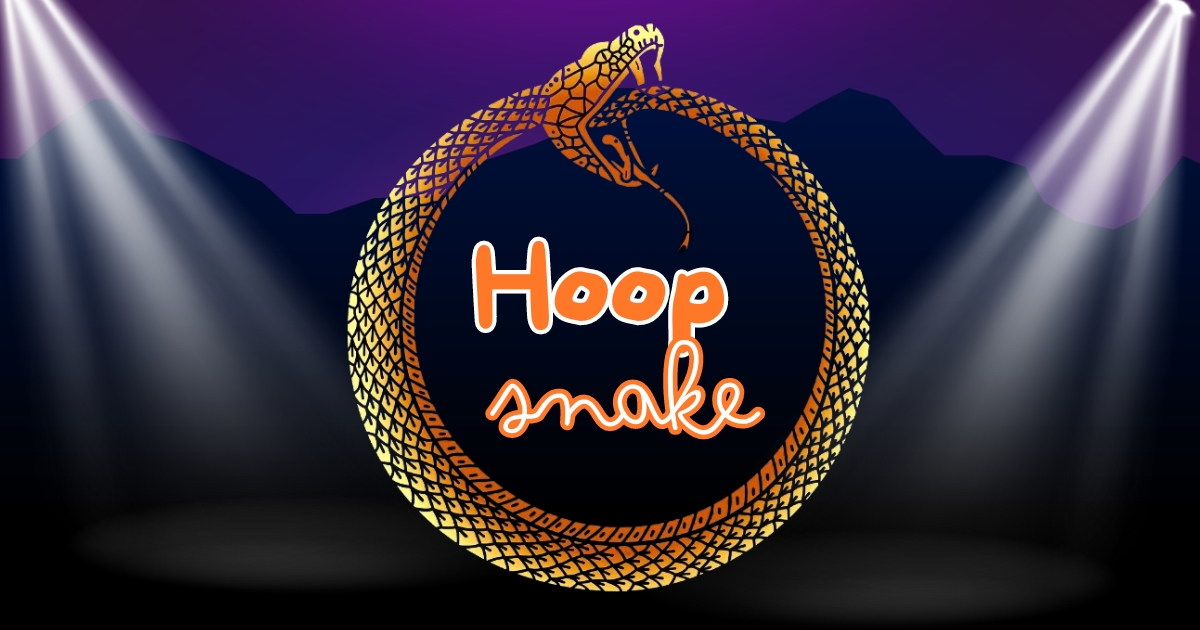In the world of folklore and myths, few creatures are as curious or as fascinating as the hoop snake. Described as a serpent that can grasp its tail in its mouth and roll like a wheel, this mythical creature has captivated the imagination of people for centuries. But is the hoop snake real, or is it just a tall tale passed down through generations?
In this blog post, we’ll explore the top 5 fascinating facts about the hoop snake and delve into the legend’s mysterious origins. We’ll also take a closer look at famous sightings and why this mythical creature continues to spark curiosity, even in modern times.
1. What Is a Hoop Snake?
The hoop snake is a legendary serpent said to have a unique and rather bizarre method of moving: it grabs its own tail with its mouth and forms a circle or “hoop,” allowing it to roll downhill or across flat land like a wheel. According to the myth, the hoop snake can move at great speed and is almost impossible to outrun. What makes the legend even more terrifying is the claim that the hoop snake has a venomous stinger at the end of its tail, which it uses to attack its prey.
Many tales about the hoop snake originated in North American folklore, particularly in the Appalachian Mountains and southern United States. It is often described as a creature of the wild, inhabiting remote areas where it is rarely seen by people.
Though no scientific evidence has ever been found to support the existence of a hoop snake, the myth has persisted for generations, making it one of the most famous legends in American folklore.
2. Top 5 Fascinating Facts About the Hoop Snake
While the hoop snake is a creature of myth, there are many interesting aspects of this legend that continue to intrigue people today. Here are the top 5 fascinating facts about the hoop snake:
1. Unique Rolling Motion
- The most distinctive feature of the hoop snake is its supposed ability to form a hoop by grabbing its tail with its mouth and rolling at high speeds. This rolling motion is what separates the hoop snake from other snake myths.
2. Venomous Sting
- According to the legend, the hoop snake’s tail is equipped with a venomous stinger. It’s said that if the snake’s stinger touches a tree or other object, it will cause that object to wither and die, giving the snake a fearsome reputation.
3. Sightings Across the U.S.
- Reports of hoop snake sightings have been recorded in various parts of the United States, particularly in the southeastern and midwestern regions. Despite these claims, no physical evidence of a hoop snake has ever been presented.
4. Roots in Early American Folklore
- The hoop snake myth is deeply rooted in American folklore, with stories dating back to the 18th and 19th centuries. Early settlers and pioneers shared tales of the hoop snake, contributing to its status as a cultural icon.
5. Comparison to Other Mythical Snakes
- The hoop snake is often compared to other mythical snakes, such as the Ouroboros, an ancient symbol of a snake eating its own tail. However, unlike the Ouroboros, which represents infinity and cyclic renewal, the hoop snake is associated with danger and speed.
These fascinating details show why the hoop snake has remained a captivating figure in folklore, despite its seemingly fantastical nature.
3. The Origins of the Hoop Snake Legend
The story of the hoop snake has its roots in North American folklore, particularly in the Appalachian region and the southern United States. The legend was likely passed down through oral storytelling traditions, with different versions of the tale appearing over time.
The myth may have originated as a way to explain strange or unexplainable natural occurrences, such as fallen trees or mysterious deaths of livestock. The idea of a snake that could roll at high speeds and deliver a deadly sting would have captured the imagination of early settlers, leading to the spread of the hoop snake legend.
It’s also possible that the myth was influenced by other snake stories from around the world. For example, the Ouroboros, a snake that forms a circle by eating its own tail, appears in ancient Greek, Egyptian, and Norse mythology. While the hoop snake is more violent and aggressive in nature, both creatures share the imagery of a circular, tail-biting serpent.
Over time, the hoop snake became a staple of American folklore, with stories being passed down through generations, eventually becoming part of the cultural fabric of rural communities.
4. Are Hoop Snakes Real or Just a Myth?
Despite numerous reports of hoop snake sightings, there is no scientific evidence to support the existence of this creature. In fact, biologists and herpetologists have debunked the myth, explaining that no snake is capable of the behaviors described in the hoop snake legend.
Snakes, by nature, rely on slithering as their primary mode of movement, using the muscles in their bodies to propel themselves forward. The idea that a snake could grab its tail, form a perfect circle, and roll like a wheel defies the laws of physics and biology.
Many hoop snake sightings may have been cases of mistaken identity. For example, some people might have seen eastern coachwhip snakes or black racers, which are known to move quickly and erratically, leading to the false belief that they were witnessing a hoop snake.
Even though it has been debunked by science, the hoop snake myth continues to thrive in folklore. Part of its enduring appeal lies in the mystery and excitement it creates, as well as the way it taps into humanity’s fascination with the unknown.
5. The Hoop Snake in Popular Culture and Folklore
The hoop snake has left a lasting impact on popular culture and has appeared in various forms of literature, art, and storytelling over the years. Although it is mostly regarded as a myth, the image of the rolling snake has fascinated generations of people.
1. Folklore and Tall Tales
The hoop snake is often included in collections of American tall tales, along with other mythical creatures like the jackalope and Paul Bunyan. These exaggerated stories, often told for entertainment around campfires, helped keep the legend alive in the rural communities of the Appalachian Mountains and the American South.
2. Literature
Several authors have referenced the hoop snake in their works, using it as a symbol of mystery, danger, or the unknown. The creature’s strange behavior and mythical status make it a perfect fit for fantasy novels and folk-inspired tales.
3. Art and Illustrations
Artists have depicted the hoop snake in paintings and illustrations, often emphasizing its impossible, circular form. These images have helped bring the legend to life, contributing to the visual representation of this mythical creature.
4. Educational and Cultural References
In some cases, the hoop snake has been used in educational contexts to explain the difference between myth and reality. Teachers and storytellers use the hoop snake as an example of how legends are created and passed down, even when there’s no scientific basis for them.
Through these various forms of popular culture, the hoop snake continues to be a symbol of American folklore, representing the power of storytelling and the allure of mystery.
6. Famous Hoop Snake Sightings: Myths or Misinterpretations?
Over the years, there have been several famous reports of hoop snake sightings. However, most of these stories lack credible evidence and are often dismissed as hoaxes or misinterpretations of natural phenomena.
1. The 1800s Pioneer Sightings
One of the earliest and most famous stories of the hoop snake comes from a pioneer settler in the early 1800s. The man claimed to have seen a snake grab its own tail, form a hoop, and roll down a hill at an incredible speed. However, no one else could verify his account, and the story was considered an exaggeration.
2. The 20th Century Hoax
In the early 20th century, a photograph circulated that allegedly showed a hoop snake in motion. The photo, however, was later proven to be a hoax, and no physical evidence was ever found to support the claim.
3. Misidentifications of Other Snakes
In many cases, hoop snake sightings are simply cases of mistaken identity. Fast-moving snakes like the coachwhip or black racer have been misidentified as hoop snakes due to their quick movements and erratic behavior. Some people may have seen these snakes fleeing from predators or moving quickly through brush, leading to the belief that they were rolling like a wheel.
These sightings, while entertaining, do not provide any solid proof of the hoop snake’s existence. Still, they continue to add to the myth’s intrigue and mystery.
For more exciting blogs, visit our homepage Magzineco.
Conclusion: The Enduring Legacy of the Hoop Snake Myth
The hoop snake may be a creature of legend, but its impact on American folklore is undeniable. From its origins in pioneer stories to its presence in popular culture, the hoop snake continues to capture the imagination of people who are drawn to the mysterious and the unknown.
Even though there is no scientific evidence to support the existence of hoop snakes, the legend lives on through storytelling, art, and literature. Whether viewed as a cautionary tale, a piece of entertainment, or a symbol of the wild frontier, the hoop snake remains one of the most fascinating myths in American culture.
While it may never be proven real, the hoop snake will likely continue to roll through our imaginations for generations to come.
FAQs About the Hoop Snake
- What is a hoop snake?
- A hoop snake is a mythical creature said to grab its tail in its mouth and roll like a wheel. It is a popular figure in American folklore.
- Are hoop snakes real?
- There is no scientific evidence to support the existence of hoop snakes. They are generally considered to be a myth.
- Where did the hoop snake legend originate?
- The hoop snake legend likely originated in North American folklore, particularly in the Appalachian Mountains and the southern United States.
- Why are hoop snakes considered dangerous?
- According to the myth, hoop snakes have a venomous stinger on their tail that can cause objects or trees to wither and die upon contact.
- What other mythical creatures are similar to hoop snakes?
- The Ouroboros, an ancient symbol of a snake eating its own tail, is similar to the hoop snake in its circular form, though it represents renewal rather than danger.
- Have there been any credible sightings of hoop snakes?
- While there have been reports of hoop snake sightings, none have been scientifically verified, and many are considered hoaxes or misidentifications.
- Why do people still believe in hoop snakes?
- The hoop snake legend persists because of its role in folklore and storytelling, capturing the imagination of those who enjoy tales of mysterious creatures.
- What is the hoop snake’s connection to other snake myths?
- Like many snake myths, the hoop snake may have roots in ancient stories and symbolism, such as the Ouroboros, which represents infinity and cyclic life.
- Is the hoop snake mentioned in any literature?
- Yes, the hoop snake has been referenced in various works of literature, particularly in collections of American tall tales.
- What is the scientific explanation for hoop snake sightings?
- Most hoop snake sightings are likely misidentifications of fast-moving snakes like the coachwhip or black racer, which can move quickly and erratically.



